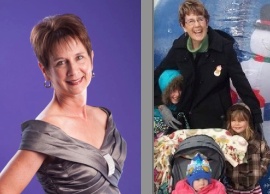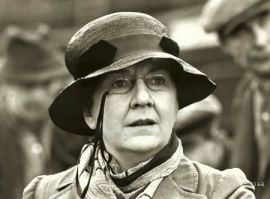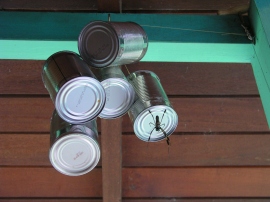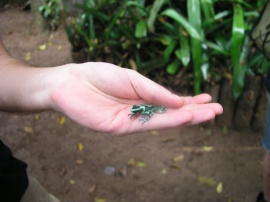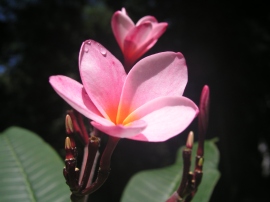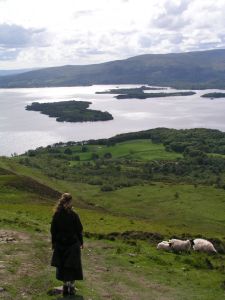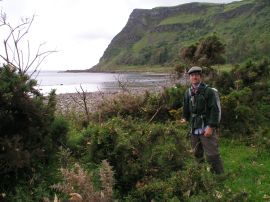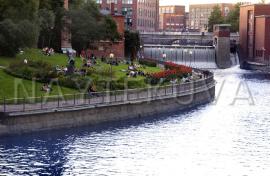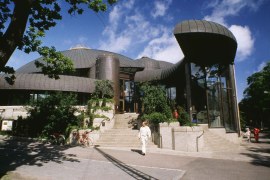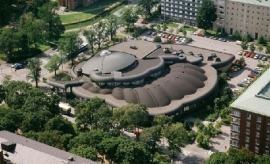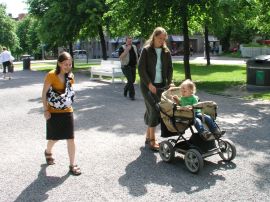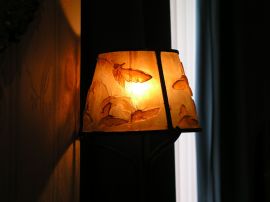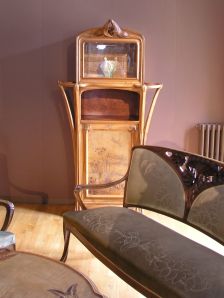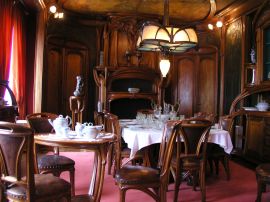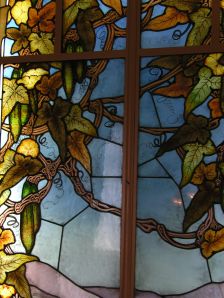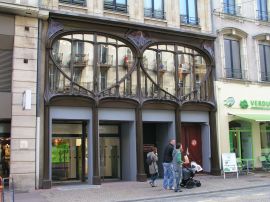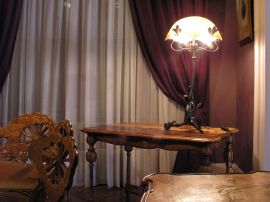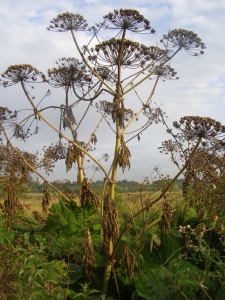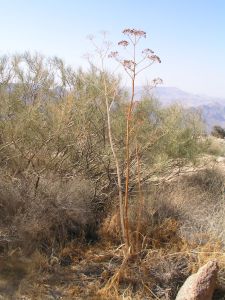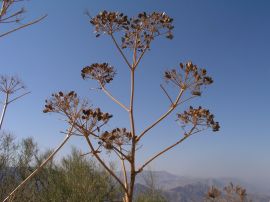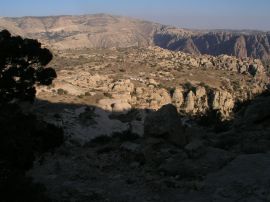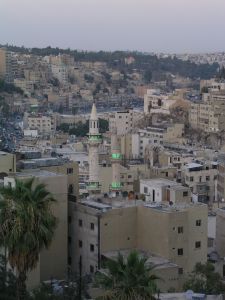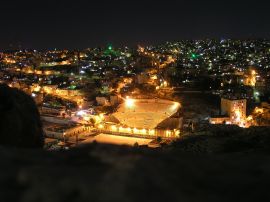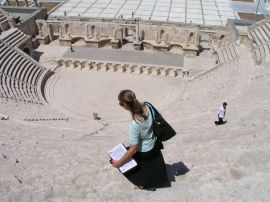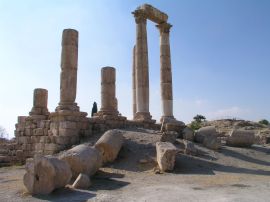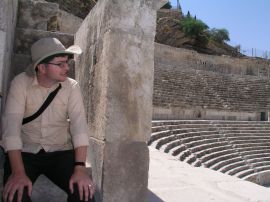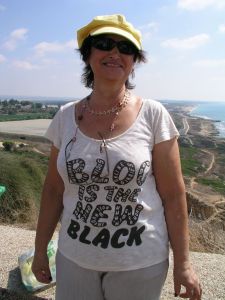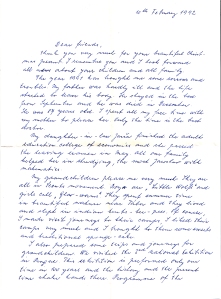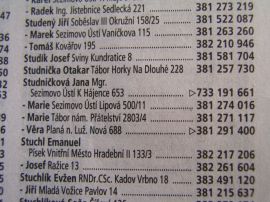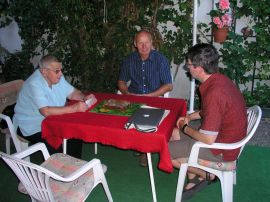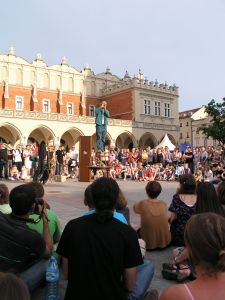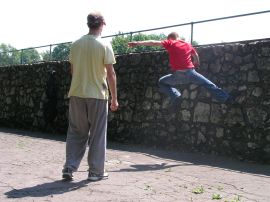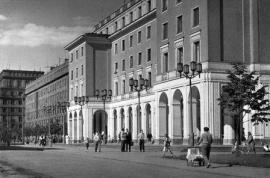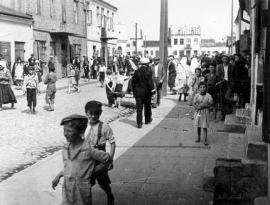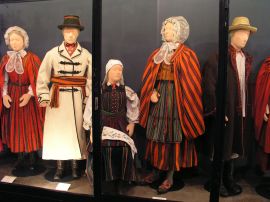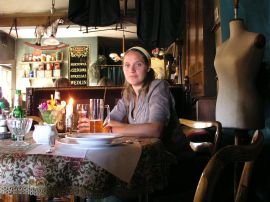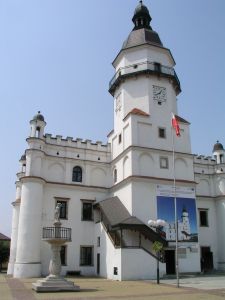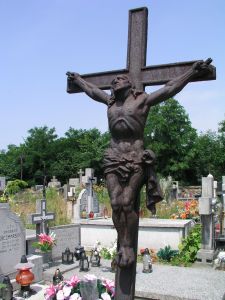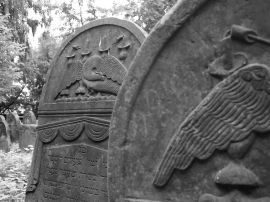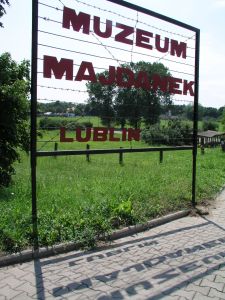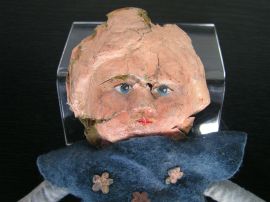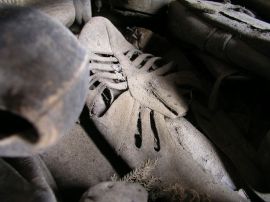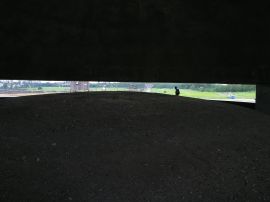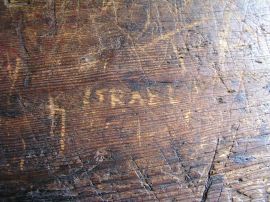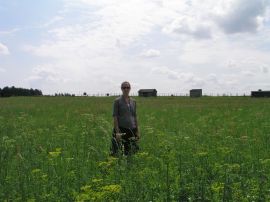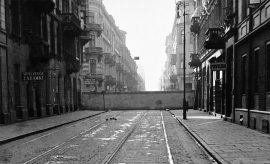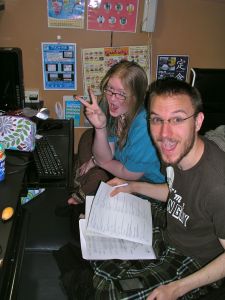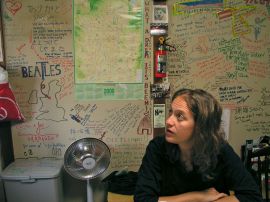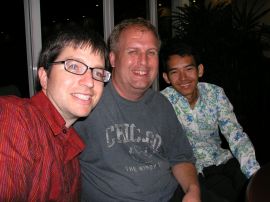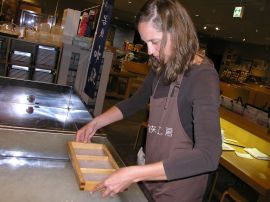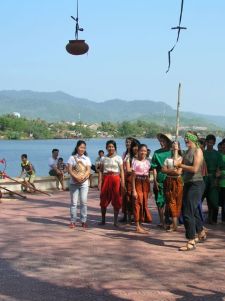This Is Not a Postcard
Tales of 2 people on 3 continentsBreaking the Home Fast
See you on Sinday
I returned to Ohio from Costa Rica on Erev Yom Kippur, October 7. Two of our closest friends, Paul & Krista, were getting married in Athens the following day. My attendance was unannounced, a surprise I deliciously guarded from everyone except the bride & groom’s mothers.
I had made up my mind to participate in the traditional Yom Kippur fast though I didn’t expect to attend services. Yom Kippur is my favorite Jewish holiday because it pushes several buttons for me: Recognition of sins committed; reflections on continuing social injustice perpetrated by both Jews and others; and opportunities for redemption through atonement. All apply to both the personal and collective realms.
I also like the fact that there’s nothing to buy for Yom Kippur other than chopped chicken liver.

Aforementioned appetizer, otherwise known as "chopchikinliver" (all one word) by unsuspecting children
This calls to mind a simultaneously self-effacing and self-aggrandizing Jewishicism: “So what am I, chopped chicken liver?” It’s a rhetorical question offered in response to a statement like, “Thanks, Mom. But I’d really like to take a real date to the awards dinner.” Chopped chicken liver gets a bad rap, y’all.
Anyhow, back to sin.
I really like thinking and talking about sin because it legitimizes the drive for social change. Jews have always gone in for social change, ever since the days of enslavement in Egypt (for obvious reasons, one might add). Jews are generally apt to believe that oppression in society is real and troubling, although we may disagree on its scale or the details of its manifestations. Jews also commonly believe that one should involve oneself directly in efforts to combat oppression, at both individual and communal levels.
As a result, we MoT (Members of Tribe) have been disproportionately involved in a whole host of left-leaning social change campaigns aimed at righting wrongs committed against both Jews and non-Jews, from Socialism to Zionism to the labor and American civil rights movements.
Yom Kippur presents us with a formal opportunity to be reminded of the grounds for our social change activities – past, present and planned. And it also offers a conveniently ritualized means of punishment: the 24-hour food and water fast.
I enjoy fasting. For one thing, on the cosmic sin-o-meter I tend toward Gluttony. For another thing, food tastes really good when you haven’t had any in 24 hours (see “Gluttony,” above). Thirdly, and perhaps most importantly, fasting allows you to focus on Things That Really Matter. It clears and sharpens your mind. It gives you space to plan how you’d like to continue once the fast is broken. And it also provides you with a timeframe ‘til the next psychic check-in – Yom Kippur next year.
The holiday closes with a loud blast of the shofar, meant to rouse you from your moral slumber.
[VIDEO: In true YouTube form, dog gets in on Yom Kippur act]
At sundown on Yom Kippur, I broke my fast at Paul and Krista’s wedding. And boy, was I hungry. It was a fast that had lasted for eight full months.
Recipe for a Home Fast
Traveling is like a home fast. You voluntarily give up a whole bunch of things that are normally essential for life: Your own private and sheltered space, access to friends and family, familiar surroundings, a clear role in an established community, useful objects and tools, a shared language and culture, a known climate and topography. Your dogs.
It is an incredible privilege, of course, to be able to unhinge yourself from the predictable, comfortable and familiar from time to time. James and I have been blessed with abundance, both tangible and intangible, and it was this “home abundance” that gave us the latitude to leave and meaning to our travels. Similarly, a proper food fast is most impactful when one has been eating enough on all the other days.
In the past, I had experienced a disagreeable lack of connection and feeling of being lost when I traveled for any real length of time. I still enjoyed it overall, but that isolation I felt started to wear on me more and more over the years. To the point where I really didn’t want to participate in random tourism anymore in places where I didn’t know anyone or had no specific reason for being there.
This trip was entirely different. My very best experiences while traveling brought me closer to my self, my loved ones, and my loved things (places, ideas, objects). In many cases, I think it was because I feel attached to home and to people that traveling felt so good.
And it was also the reason that I relished being home again. I wasn’t homesick in the sense of wanting the trip to end; I was just inwardly thrilled with the idea that I would eventually reclaim each of the trappings of a good home and a good community. It was delicious anticipation rather than desperate hunger.
As we traveled, we noticed elements of what made for a wonderful home all over the world. We mentally collected them (links open our own photos):
- Flea markets and stoop sales
- Shared hot bathing spaces like saunas, onsen and Turkish baths
- The right space for the right function – no more, no less
- Scottish wool
- A rich and diverse ecosystem
- Neighbors who are willing to work to create a better world
- Real food
- Networks that support sharing of skills and stuff
- Seasons and seasonal rituals
- Creative re-adaptation of places and things that no longer serve their original purpose
- Beer mixed with fruit juice
- Handcrafted tools and objects
- Small and modest homes
- Nearby farms and gardens
- Infrastructure that forces you to use less water, electricity, gas, etc.
- Pickled fish (Sonia, not James)
- Pine tar and licorice flavored foods (James, not Sonia)
- Well-attended cultural programs
- Domestic and wild animals
- Czech fruit dumplings (click here for a recipe)
- Living museums
- Little towns and little cities
- Big trees
- Collective humility
- Community pride
- Trams
- Wild edibles and people who know how to find them
- Jordanian mosaics
- A culture that values the outdoors and celebrates natural beauty
- Water
- Old buildings and old traditions
- Artisanal cheeses
- Walkable and bikable streets
- Welcoming and beautiful public spaces
Home Is Where the Hart Is
Now that we are back in Athens, I am able to really savor all the things about it that make it a great home. I am also able to more clearly see the aspects of it that make it less than ideal – my allergies, high ratio of bars to non-bars uptown, threat of damaging resource extraction as an economic driver, a distinct lack of tram infrastructure, transient friends and potential friends.
James and I are going to hang out here for a while. Both of us have some exciting projects underway. We still don’t know where it is we’re headed next, but for now this is a good base of operations. We would like to continue to do some traveling in North America by car this winter. We are both really looking forward to snow.
We have some nice tenants/house sitters who will be in our house on Spring Street until February. This has opened up a wonderful opportunity to experience life in the country until then. We are staying in an adorable tiny house created by a local builder named Danny Yahini, just 300 square feet in all. It’s a third the size of our home in town.
The house is for sale and entirely mobile – it can be picked up and driven down the highway like a trailer. It is just our size, nothing more and nothing less.
We are truly blessed.
We still have some more stories to share so don’t be surprised if you see a few more posts from us in the months ahead. At a minimum, we will share all the updated photos of our antique postcards which we captured on location around the world. Lots of love to you all!Pop Math/ Pop Sociology
The emotional pull of Athens is inversely proportional to the cube of the distance you are away from it.
> Part One – First the bad news… a lost opportunity
I’m still in here in Costa Rica now. Sonia went back to the U.S. four weeks ago to represent us at our friends’ wedding. If you’d have asked me soon after we arrived at the beginning of October what I thought I might write in this post about Costa Rica just before going home, I would have said “I’ll probably talk about sea turtle nests on the beach, or close encounters with sloths and monkeys, or amazing food, or snorkeling over the beautiful coral reefs and hikes in the jungle, or maybe the nice couch-surfing hosts we would meet here.” While I did see the sloths and monkeys up close, none of these other things happened. It’s not because those other things aren’t here. They probably are.
I will tell you about what I did experience – a strangle little roadside community named Playa Chiquita. It’s a stone’s throw from the Caribbean about a half an hour’s drive north of Panama. A surprisingly large number of North American and European expats that I met there told me that they came for their retirement and now were in the process of building homes. Most of the businesses (hotels, restaurants, etc.) appeared to be owned by Central or South Americans who were not from Costa Rica with just a handful of businesses owned by North Americans or Europeans. Meanwhile, all of the native Costa Ricans were mostly behind the scenes cleaning the hotels, cooking the food, mowing the grass, etc.
In Playa Chiquita, there is a real siege mentality among the newly arrived expats settlers. They talk anxiously about the latest crimes: break-ins, robberies, etc. the night before. They share tips about how to burglar-proof your home, organize neighborhood watch patrols, and give out handy raffle prizes such as this one at the expat beach party:
The non-native business owners in Playa Chiquita have been there longer – and maybe since they employ many of the “locals” they feel less threatened by crime. I don’t know if that’s true. However, everyone you talk to acknowledges that the newcomers are preyed upon by the locals . The explanation for this behavior is usually summed up with one phrase “they’re looking for money for drugs”.
However, I never saw or felt threatened by the presence of “drugs” during my time here. I was never robbed or my house burglarized. Regardless, with all of these warnings weighing on my mind I found myself increasingly staying at the house, rationalizing strange noises in the night, and before long feeling stressed out just like all of the other expats. As a result, I didn’t get to experience Costa Rica in the manner I had hoped. I got to experience the inside of my house.
Why did this happen? I thought about blaming Costa Rica for my lack of touristic fulfillment. Was it like this everywhere in this part of the country? Then I thought that maybe I was really to blame for not wanting to enjoy the visit enough. It is true that I wanted to stay here mainly because we didn’t have a house to live in when we returned home and I thought that I could use the time here to put together a plan for life and work after a year travelling around the world. But I did want to get out a little and experience the place.
I recalled my visit to the nearby town of Coccles during my first week in Costa Rica. Coccles is immediately next to Playa Chiquita – an easy walk about a mile away. In Coccles there were just as many or more expats building their homes as in Playa Chiquita. However, the feel of the place was completely different. The expats actually knew their local neighbors by name. They stopped to talk with each other on the street. Families who had lived in Coccles for generations still lived there along with their relatives. Most of the businesses were owned by native Costa Ricans. There was still crime – but nowhere near the levels of Playa Chiquita. The Coccles community felt so much more whole.
It was then that I recognized the essential difference between Playa Chiquita and Coccles. In Playa Chiquita I observed an enthusiasm by the community for maintaining the segregation between their respective groups and the apathy within each group toward offenses/ crimes committed against the other groups. Within the community of Coccles everyone had the sense that they were in the same group. It didn’t matter where you were from or what you looked like. Who should I blame for my miserable time in Playa Chiquita? I believe that the community – or lack of community – is responsible.
From the many conversations that Sonia and I have had on this trip, she’s convinced me that when people lose their sense of community, the resilience of the community is weakened and members suffer. I’ve heard it said before that “crime is a disease.” Not surprisingly, weak communities are at greater risk of coming down with a bad case of crime. Playa Chiquita is sick with crime. While right next door, Coccles is healthy and looks to stay that way. Drugs weren’t the difference – they’re an easily recognizable part of the background noise and odor everywhere in Costa Rica. In Coccles the strength of the community was the difference.
> Part Two – Now the slightly better news… the things we saw outside of Playa Chiquita
I’ve now left Playa Chiquita and am staying in Coccles. It is such a relief – I love it here. I’m staying with a wonderful couple, Mary and Russ. After a couple days with them I’ve managed to recover (nearly completely) from the stress of the previous few weeks. I’m just now beginning to remember that Sonia and I did have some fun here together before she went back to the U.S. Here are some of the highlights:
> Part Three – Now the really good news… coming home to Athens
I’ll be flying back to the U.S. and then to Athens this Saturday. I didn’t miss Athens all that much for most of this year. But the closer we get, the more I miss it. We were in so many different places and met so many wonderful people and their communities. When asked whether I liked a particular place – I would try to recall the “feel” of the place. I believe that the warmness of this “feeling” depended mainly on my perceived strength of the community. I have that warm feeling for Athens and that’s why I will be happy to be back.
The entire trip was not something that we planned very far in advance. Sonia first proposed the idea last December – after I had already decided to leave my job. We did not leave our jobs in order to travel. Over the years I had often felt that if I ever reached the point in my professional career where I had exhausted all the reasonable options for interesting work in Athens – that then I would have no problem leaving. Following my one and a half year stint commuting 70 miles to Columbus and back each day – I thought that my days in Athens were likely numbered. It didn’t occur to me until very late in this trip that maybe Sonia knew that it was only by being away from Athens for so long that I would realize again what a special place it was. Sonia’s never forgotten that. I’m extremely grateful to her for helping me remember.
This post was supposed to be about my relationship with Costa Rica. But I think it might actually be more about my relationship with Athens. Athens, I’ll see you soon.
Listen to the minor cords
When we try to pick out anything by itself we find that it is bound fast by a thousand invisible cords that cannot be broken, to everything in the universe. (John Muir, 1869)Part I: Birds of a Feather
One of our delights while traveling consists of finding connections between presumably unrelated places. It’s like coming across a sparkling line of spider web that you have to tilt your head just right to see. Once you see it, others magically come into view.
I’ll give you an example:
During our time in Scotland, we heard every so often about a critically endangered bird called a capercaillie (pronounced “kayper-kaylee”).
The elusive capercaillie is the largest grouse in the world, inhabiting the (similarly endangered) forests of the Scottish Highlands.
I had never heard of a capercaillie before coming to Scotland, but James recognized the name as the name of a band that performs from time to time on NPR’s “Thistle & Shamrock.” It’s an apt name for a Scottish band, in fact, because traditional Scottish dances are called ceilidhs (“kaylees”), otherwise known as “contra dances” in the US.
It’s also apt because the capercaillie itself dances in an elaborate courtship display.
Up until the late 1700’s Scotland was still largely covered with Scots pine, the preferred habitat for capercaillies. Then a combination of factors including massive deforestation as well as the onset of the “Little Ice Age” conspired to wipe the capercaillies out.
Today there are less than 1,000 capercaillies left in Scotland, largely confined to a patch of land of just 11 square miles. Some experts say the real population figure is probably closer to 500. In 2009, a census of the Loch Lomond population counted just five individual birds, a decline from the 32 individuals counted ten years earlier.
James and I snuck up on a small group of capercaillies while we were hiking on the Isle of Mull. They explode out of their hiding places like wild turkeys, scaring the bejeezus out of you.
>> fast forward to Finland
Our very favorite city in Finland was Tampere, once known as the country’s industrial “Manchester.” Tampere has also historically been a hotbed for labor and socialist organizing.
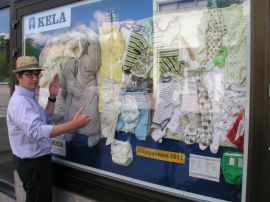
James shows off the package that all Finnish parents receive for free whenever they have a baby. Long live Scandinavian socialism!
These days, Tampere is a beautiful, vibrant town that has reinvented its old factory buildings into gorgeous downtown centerpieces.
It is also home to a great university that I profiled on my Parlez-Vous Green Campus? website.
When we first arrived in Tampere, one of our couchsurfing hosts took us on a walking tour of the major sights, including their fantastic public library designed by a couple of Finnish architects named Reima and Raili Pietilä.
The library has earned itself an endearing nickname: “Metso.”
Why? Because from above, it seems to resemble a beloved local bird by the same name.
Despite her superior English language skills, our host Johanna had to admit that she was at a loss to translate.
She took us inside to see a stuffed version of the bird in a case in the lobby. Before I even saw it, I knew what it would be.
Life is just like that sometimes.
After doing a bit of further research, I learned that the capercaillie actually became extinct in Scotland back in 1785. Today’s population was bred from capercaillies brought over from… the Scandinavian peninsula.
Part II: Burning down the Caucasus
Whenever I go to Nancy, France where my mother was born and raised, I make a pilgrimage to the Musée de l’Ecole de Nancy. This last visit was particularly special because I was with my parents who were in France celebrating my mother’s 70th birthday and their 50th wedding anniversary.
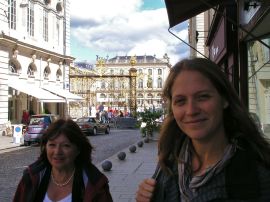
With my maman in her home town. Notice Place Stanislas in the background, Nancy's magnificent central square.
The Ecole de Nancy museum showcases the incredible craftsmanship and creativity of local artists who contributed to the founding of the Art Nouveau movement at the turn of the last century such as Emile Gallé, the Daum brothers, Louis Majorelle and René Lalique.
The designs were always based on natural elements – plants, flowers, insects, fish.
One of their favorite motifs was a highly invasive plant called “ombelle” in French (Heracleum mantegazzianum). In English, this plant goes by a somewhat less refined common name: Giant hogweed.
Hogweed is phototoxic, meaning that its sap causes severe blisters to appear on skin that has come into contact with it. It was introduced from the Caucasus region (Central Asia) as an ornamental in Britain and later France, and it has since made itself highly unwelcome, displacing native species and terrorizing unsuspecting victims who have unwittingly reached out to touch it.
ABC News described hogweed just last year as the “summer plant from hell.”
Despite its obvious shortcomings, giant hogweed was showered with affection by the artists in Nancy. In fact, it is even planted in the gardens surrounding the museum, though new shoots are systematically removed – with gloves on.
>> fast forward to Jordan
We came across this fine specimen in the middle of the Dana Nature Reserve. I would have stood next to it for scale, but I was scared to get anywhere near it.
James and I have a theory about how this plant ended up here. But first let’s back up a little and talk about Jordan.
Jordan is an absolutely fascinating country that has been home to many different cultures and peoples throughout its history. And still is.
Its capital Amman is a sprawling, cream-colored city whose homes, mosques and staircases spill over tightly packed hills.
Amman started out as the capital of the Ammonites, referred to in the Bible as Rabath-Amman. King David slaughtered Uriah the Hittite here.
[At which point you say to yourself, “Ah, of course! Uriah the Hittite. I always wondered how he died.”]
Later, the Romans renamed the city Philadelphia. That was back when it was one of the most important centers of power in the Roman Empire. Its amphitheater seated 5,000 spectators at a go.
Amazingly, by 1900 Amman had shrunk to a real 2-horse town; the city counted just 400 total inhabitants.
Most of its residents at that time were Muslim Circassians. The Circassians had been expelled from their homeland by the Russians at the end of the Caucasian War in the 19th century. Some early Circassian settlers took up residence inside the ruins of Amman’s Roman amphitheater.
Back to our theory about the hogweed: Did the Central Asian Circassians drag that infernal plant along with them as a bitter reminder of home? Perhaps they didn’t want to feel too sentimental about the motherland they had left far behind. Or maybe they planted it as a defensive measure against the Russians should they ever come back to town.
Sure, why not? This theory was sounding better and better all the time.
Unfortunately, we later learned that the plant in Jordan is native to the Mediterranean region: Ferula communis, aka “giant fennel.”
Family? Umbelliferae. Also the family of the giant hogweed.
Close enough.
Folks, don’t forget to request a real, live postcard before you leave this page! We love sending them to you. Also, there are loads and loads of pictures from France on Flickr to look at if you feel so inclined.p.s. Blog is the new black.
Tábor? no! They should call it Tárexciting!
Sonia and I recently visited the city of Tábor in the South Bohemia region of the Czech Republic. My maternal grandfather’s family (with the surname Klinke) emigrated from Tábor to the United States sometime in the 19th century.
Tábor has been through a lot in the past two thousand years. The Celts established a settlement in Tábor around 100 B.C. and portions of existing buildings and the castle date to the 13th and 14th centuries.
The Protestant and Catholic armies fought here during much of the 15th century. The Swedes invaded in the 17th century during the Thirty Years War. Until World War I, the country was under the control of the Austrian Empire. In 1918, following World War I, the Czech and Slovak peoples were united as one country called “Czechoslovakia.” During World War II the Nazis invaded. Then in 1968, the Soviet Union invaded Czechoslovakia and didn’t leave until 1989.
KLINKE
In 1966, in the middle of the Cold War, my mother and grandmother had visited Tábor in search of their Klinke clanmates.
At the tail end of their visit, they encountered some problem with their train tickets and had difficulties at the train station getting it resolved due to the language barrier. Eventually, they were assisted by the station master, Otakar Studnicka. Otakar not only got them onto their train, he also took the liberty of upgrading their seats to first class.
After returning to the U.S., my mother sent a thank you note to Otakar at the station. He replied back at the holidays with a card.
That began a written correspondence that lasted over 25 years.
At Christmas, the families would exchange letters and gifts. It was always exciting to open the package from Tábor containing assorted calendars, children’s books, dried mushrooms, handmade lace, tablecloths and ornaments.
My mother showed us some of the items when we visited Sandusky before leaving on our trip.
My mother would send them clothing in return: jeans, tee shirts, etc. for their children.
My mother has saved many of the letters. Otakar would write about the news from his family and daily life in Tábor with the Soviets. The correspondence continued until 1985 when my mother was notified by Otakar’s wife, Maria Studnickova, that he had died unexpectedly.
My mother continued exchanging letters with Maria until 1992. This correspondence of more than 25 years had spanned the entire Soviet occupation of Czechoslovakia. Maria and my mother have never met in person.
I had visited Prague in 2004 and decided not to make a side trip to Tábor because I assumed that after such a difficult history there wouldn’t be much left of the city worth seeing.
However, Sonia talked me into visiting Tábor on our current trip. I remained doubtful that we would find much of interest there.
We walked out of the Tábor train station and into the Old Town. OMG!
The city was very nice and the old town amazingly beautiful. The medieval-era buildings were being well cared for. I could have written an entire post just about the buildings.
When we checked into our B&B, I checked the local telephone book for evidence of any Klinkes (or surname variants, e.g. Klinkova, Klinek, Klinka, Klika, etc.) without any success.
I then looked in the telephone book for listings for Maria (Marie) Studnickova.
Sonia asked the B&B proprietor to help us contact her, explaining the background of our relationship.
In the early evening, we were taking a nap when there was a knock at the door. The B&B proprietor excitedly told us, “They’re here!”
The “reunion” with Maria and her son, Otakar, was fairly emotional. They said that it was an incredible shock and happy surprise to hear that we were in town.
Maria and Otakar very friendly and curious. Maria retired from the flower shop 25 years ago, but still lends them a hand every year to meet the huge demand for grave flowers around All Souls Day in November. She lives in the same house that she shared with her husband.
This is an important year for the Studnickova family; both of her son Otakar’s children are getting married and Maria celebrated her 80th birthday. Maria is in charge of the flowers at the weddings.

Maria with the wedding bouquet she made for her grandchild's wedding. She grew the sunflowers herself.
She speaks little English so her son interpreted for us. She told us that the letters that she had sent after her husband died were translated into English by her children.
We showed her images on the laptop of some of the letters that she had sent – including some recipes and hand drawn sketches of how to correctly form cookies into traditional shapes. Maria then reached into her pocket and produced the wedding photos of my parents that my mother had sent her. It was amazing to be sitting at a table in a Czech town that we had never visited, and be looking at pictures of my family.
Maria and Otakar invited us to dinner at a restaurant in the town square. We talked about their family, the town and the transition to life after communism in the early 1990s. Private property (factories, farms, etc.) were slowly returned to the original owners – although often in much neglected condition.
Sonia and I didn’t turn up any lost Klinkes in Tábor, but we made some new friends that I felt like I had already known for a very long time.
THE END
P.S. Keep sending us those postcard requests!
Chapter X. In which the author travels to her ancestral homeland and subsequently finds parallels between Warsaw and San Antonio, Texas
James and I are leaving Poland on a train – an experience that many of many of my forebears and fellow Jews did not have the privilege of enjoying. The dust that was their flesh and bones now lies heaped in piles at Holocaust museums and scattered in nameless fields and undiscovered ditches.
I leave feeling depressed, angry and exhausted. But most of all I leave feeling disappointed.
Disappointed in humanity and the ways in which it has not proven itself worthy of life on this beautiful planet. Disappointed in the ways in which it continues to fall short.
Let me back up a little, though, before I get into the disappointing bits.
I. Old and Nowa (New) Krakow
The most breathtaking central square I’ve ever seen is in the Old Town in Krakow. It is simply magical.
We ended up spending quite a lot of time there – meeting up with friends, joining local walking tours, viewing various street theater performances.
Most of the street theater was complete garbage, unfortunately – there was a festival going on that didn’t seem particularly adept at choosing quality acts.
Whenever I got bored or irritated during any of the performances, however, I just let my gaze drift over to the horses and carriages, cafes, medieval buildings, towers, birds, clouds. I felt truly inspired.
One of the things that is compelling about the squares in Poland is that they feature buildings in their centers. So the square is really a ring of pedestrian traffic around a central structure. This creates a more intimate atmosphere around its corners. We also saw this in Lublin. It’s sort of like partitioning areas in a restaurant, making it cozier. Poland’s squares feel quite cozy, despite their ornate architecture and grand scale.
Another thing we did in the square was help our host Andrzej get set up for his “living statue” act outside the Basilica.
You may have seen these folks before; they dress up to look like a statue (e.g. the Statue of Liberty), and then they stand on a podium in a popular tourist location and freeze.
Passers by throw coins in their hats, sometimes posing to take a photo. This cracks me up because everyone is definitively frozen in a photo – not just the performer. It’s only in dynamic time and space that you are able to appreciate the artist’s oeuvre, if you could go so far as to call it that.
Andrzej is also great at moving through space; he leads “parkour” workshops for street kids several times per week.
Parkour is a sort of sport or physical art form that involves moving through an urban landscape in the most efficient and elegant way possible. The city essentially becomes a giant jungle gym.
Here’s a video of Andzrej from a few years back practicing his art in Krakow. Take a moment to watch, you’ll be amazed.
[Note: Andzrej is in the camouflage shirt. He had long hair then.]
The kids that Andrzej work with seem to really enjoy developing this practice, and some of them aren’t half bad themselves.
They really look up to Andzrej, who occasionally entertains them by demonstrating advanced technique and form.
Andrzej is also an environmental engineer. He’s been out of work since January, but he’s hopeful that he’ll be working again soon in that field. His wife, Krysia, is a social worker who assists homeless people with dire and critical needs. They’re a really lovely newly married couple who live in an apartment with a killer view in Nowa Huta, a sprawling neighborhood that was designed and built by the Soviets after the war. They were kind enough to host us during our stay.
Nowa Huta is a complicated and fascinating place and we were fortunate to have Andrzej as our guide there. He is determined to see Nowa Huta gain its rightful place in the culture and history books of Krakow – and not just as a punch line to some joke about the Soviets’ poor taste in architecture and urban planning.

"The People's Theater," once Krakow's premier venue for avant-garde productions. Interesting factoid: Józef Szajna, a survivor of Auschwitz and Buchenwald, became the Theatre's artistic director in 1963.
We saw a lot of potential there, and a lot of great community as well. Nowa Huta was laid out into various mixed-use residential areas with shops, health care services, schools, in each mini-neighborhood — all connected to a very grand (and yes, totalitarian) central square.
Nowa Huta is mocked by Krakowians as an ecological disaster area due to the presence of giant steelworks nearby, once the largest in all of Poland. But many efforts have been made to clean up the emissions from the plant and Andrzej was quick to point out to us that the heating of homes is now the #1 source of air pollution in Krakow, followed by automobiles, trucks and buses. Incidentally, Nowa Huta also boasts a huge area of preserved and undeveloped land right in the middle of the city. Not a park for recreation, but a true wildlife sanctuary.
And despite its close ties to Communist era ideology, it was a hotbed for Solidarity movement activism which eventually led to the democratic election of Lech Wałęsa as president in 1990.
While in Krakow, James and I also had the pleasure of exploring the Old Town, taking a long Jewish history walking tour, and visiting the giant salt mine nearby. Krakow is full of wonders.
You can view all our photos at our Flickr site.
II. Lithopolis, Ohio to Szydłowiec, Poland
One of the main reasons that James and I chose to include Poland on our trip is that we were interested in visiting Szydłowiec (in Yiddish שידלָאווצע), a town of about 15,000 located between Warsaw and Krakow.
Szydłowiec (pronounced shid-DWO-veets) is where my maternal grandfather, Albert (Israel) Grynberg, was born. His whole family emigrated from what was the Kingdom of Poland to Nancy, France in the 1910’s when he was just a boy.
Jews in France that I knew growing up did not have nice things to say about Poland.
The understanding was that 1) Poles were rabid anti-Semites, 2) all traces of Jewish history and culture had been systemically obliterated during and after the war, 3) Jews were never ever considered Poles so why should we take an interest in Poland now, and 4) the Communists turned modern Poland into a solemn, grey, industrial nightmare of a country that you’ve have to be a weirdo to appreciate.

Jewish families being deported from Szydłowiec to the Treblinka extermination camp in 1942. Around 16,000 Jews were deported in total.
No one seemed to have any interest in returning to Poland for a visit. There were a few who would go on Holocaust tours to the concentration camps, but that was it.
I didn’t feel particularly motivated to visit either, until a strange thing happened to me in Ohio.
One day last summer, James and I decided to drive over to a tiny town called Lithopolis, which was holding its nth annual Honey Fest. James had recently been trying his hand at home brewing mead, and we wanted to taste some commercial varieties.
On our way there, we stopped at a yard sale – the usual bric-a-brac, along with some interesting antique furniture. James picked out an old swivel chair. And I found a framed print of a farming scene. Price tag: $6.
I couldn’t tell you what I found so compelling about this picture. I thought it might be Scandinavian (Norwegian?); there was a snowflake design around the outside that reminded me of a Nordic ski sweater.
I felt certain that it was actually old and not just “fake old” from Pier 1. Here it is displayed on the couch in our living room in Athens.
I spent a few days after that trying to figure out what the darned thing was. I couldn’t find anything online that looked anything like it. I looked at web sites for traditional Scandavian costume; the clothing in the picture was so specific and unique, I felt sure that I would be able to recognize it in a line-up.
No luck.
I broke down and took the print out of its frame. Don’t know why I didn’t do that right off the bat. Its previously hidden title was “Opoczynskie in the Land of Radom.” The Opoczynskie, it turns out, are a Polish cultural group whose traditional costume matched the print’s exactly.
Ok, I had nailed down the people. Now what about the place? Among the very first listings to pop up in my search were archival documents of the Jewish communities in this region (Kielce-Radom governance), translated into English by a Jewish-American genealogy club.
I had a flash and called my mother who was traveling at the time. Could it be?
“So… where is our family from in Poland, anyway?”
“The area of Radom, I think. The town was called Szydłowiec.”
Amazing, no?
III. Life before death
I’m so glad that we had the opportunity to visit Budapest and Krakow before Szydlowiec and Majdanek to get a sense of the tremendous history and culture and life of Eastern European Jewish communities before the war. It would be a terrible mistake to reduce that history to a grotesque and horrifying account of the genocide and aftermath alone.
Though there are pitifully few physical remnants of those incredible communities, we were graced with many stories (and more than a few themed restaurants) which gave us a little taste of the heritage that had been lost. Who knew pickled herring was so delicious?
Jewish cultural tourism is going gangbusters these days. I would estimate that at least 60-70% of all the folks on our walking tours had no Jewish background whatsoever.
Here are some images, past and present, associated with that heritage.

The Great Synagogue seats up to 3,000 congregants. There are over 20 functioning synagogues in Budapest, currently home to Eastern Europe's largest Jewish community.

Street theater performance in Krakow by an Israeli company. It was somehow about kabbalah but I didn't get it at all.
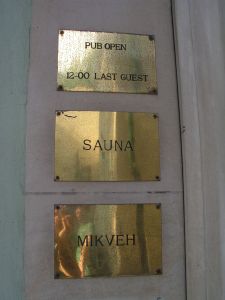
Sign outside the entrance to a fancy hotel in the Jewish Quarter in Krakow. A mikveh is a Jewish ritual bath.

Our Jewish tour guide in Budapest who was extremely well informed and really brought the history to life
IV. Oh little town of Szydłowiec
When the bus dropped us off on the side of the road in Szydlowiec, I wondered if this excursion had been a mistake. We couldn’t see any real town to speak of, just a big empty street with cars whizzing by. The first person we approached to ask for directions didn’t speak any English at all. The next person we talked to said that the one accommodation option listed in Lonely Planet had closed its doors some time ago.
However… We were told there was a nice new hostel right on the edge of town, and the young woman kindly offered to take us there in her car.
Let me just mention here that the Poles generally stuck us as extremely friendly people who went out of their way to help us out on many occasions.
We ended up staying in Szydłowiec for two nights, and we had a lovely time there. Communication with the locals was indeed challenging, but we found ways to make our questions and answers understood, largely with the help of hand signals and by pointing at things.
Once we got our bearings, we were able to appreciate the old town center as well as the local castle which has been repurposed as a museum of traditional Polish folk instruments.
Before the war, the population of Szydlowiec was 70% Jewish. There is hardly any trace of that population left today and there are no Jews living there now other than those who are just passing through.
However, Szydlowiec does have one extraordinary historical gem on display – a huge pre-war Jewish cemetery, virtually unmatched in its size and splendor anywhere else in Eastern Europe.
Over 3,100 tombstones are preserved there, representing just a fraction of the total number that once stood in the cemetery.
The stones are as beautiful as any I’ve ever seen.
A florist around the corner helped us get in touch with a person named Sława who was listed as the relevant contact on a sign at the cemetery entrance. She met us there within the hour and was able to tell us a bit about the history of the cemetery and the Jewish community in Szydłowiec.
Long story short: Jews lived in Szydłowiec beginning in the 16th Century, it was a thriving and successful community right up until WWII, in 1943 all the Jews were rounded up and deported to extermination camps. The End.
Sława is writing a book about Jewish history in Szydłowiec that will be available later this year. When I told her that my family’s name was Grynberg with a “y”, she lit up.
“Yes, there were Grynbergs here! There was a very well known and successful doctor at the hospital named Grynberg. Yes, yes. There were Grynbergs here.”
V. Depravity, death and despair
Though my family escaped the deportations in Poland having moved to France decades earlier, they did not escape deportation altogether.
My grandfather’s mother, father, three younger sisters as well as nieces and nephews were all executed either at Auschwitz or during deportation. No wonder the idea of returning to Poland sounds so distasteful.
James and I decided to visit the Majdanek extermination camp, on the outskirts of a town called Lublin. I had read that Majdanek was particularly well preserved. I also chose to visit Majdanek because I feared a tourist fiasco at Auschwitz would diminish our experience there. James and I even talked about avoiding the concentration camps in Poland completely. It seemed to fall into the strange category of “tragedy tourism” that we had observed in Cambodia. In the end, however, it was only a 20-minute bus ride away.
I will never forget this visit. Never.
I felt very sad but also very proud to be there. Through my tears, I shot images of the camp to show my family.
I don’t feel comfortable including most of the photos I took there in this post, but if you are interested in seeing them you can look through our Poland photo set on Flikr.
78,000 people were exterminated at Majdanek in total, the vast majority of which were Jews. A mere 1,500 were liberated with the arrival of the Red Army in 1943.
Here are a few glimpses into this awful place of depravity, death and despair.
As long as one descendant of European Jews survived to bear witness, the Nazis did not succeed.
VI. Reliving the Alamo
Today was a hard day, the hardest so far in some ways.
I think that after Majdanek I had been holding out a glimmer of hope that the stories of the Warsaw uprisings would renew my faith in power of (some) good people to resist and combat evil. What I came to conclude, instead, was that everyone was out for themselves in World War II and no one gave a shit about the Jews. Excuse my language. Very upsetting.
I did not enjoy the Warsaw Rising Museum.
For those who could use a little background: During World War II, the Nazis and the Soviet Union decided to divvy up and occupy what was previously the Kingdom of Poland. So Poland was no more.
Warsaw was under German rule, and that didn’t sit well with the people of Warsaw. Least of all the Jews who were rounded up and jailed inside the walls of a ghetto with pitifully few resources to support themselves: 400,000 in all, equal to a third of the city’s total population.
Meanwhile, the other residents of Warsaw essentially put up with the Nazi insanity until 1944 when many decided to participate in a massive uprising against their occupiers. They fought an all-out war for about 3 months and had some admirable successes, considering how embarrassingly they were outnumbered and out-resourced. In the end, the uprising was brutally crushed and thousands were jailed, exiled or executed. The City of Warsaw was reduced to smithereens.
Anyway, back to the museum. About 15 minutes after we got there, I said “There’s something that really bothers me about this place.”
It was a familiar feeling, actually. The last time I felt it was when we visited the Alamo in San Antonio, Texas. I’ll explain why in just a minute.
Here are some of the things that really angered me about the exhibits:
1) There was almost no mention made of the Warsaw Ghetto Uprising, which had taken place a year earlier and was the largest display of Jewish resistance anywhere during the entire war;
2) The uprising by the non-Jews had absolutely zero to do with opposing Nazi policies on the extermination of Jews and seemingly everything to do with reestablishing the Kingdom of Poland*;
3) Jews were dismissed in the exhibits either as pathetic victims or as dangerous Communist sympathizers, despite the fact that hundreds had even fought alongside the non-Jews in the 1944 uprising;
4) The liquidation of the Warsaw Ghetto and its inhabitants did not even get included as part of the background or context.
To say that the heroes of the 1944 uprising were glorified at the museum is not saying enough. I would call it outright hagiography. And the tone of the exhibits made it clear that visitors would enthusiastically share that view.
That’s why it reminded me of the Alamo. At the Alamo museum, the Texians were made out to be saints! Meanwhile, they were fighting in defense of the institution of slavery. How was I supposed to admire them? Their whole platform disgusted me.
Perhaps the members of the uprising in Warsaw in 1944 were not fighting in defense of anti-Semitism. But they didn’t seem to be fighting against it, either.
I am sympathetic to the need for Poles to reclaim their dignity after the war and after the Communist era. But that cannot and should not come at the expense of the Jews who have already suffered so greatly.
VII. Parting thoughts
I’ll let you go know, I know this post has been long and drawn out.
There are a few things that I wasn’t able to address that bear mentioning — the horrors of post-war Soviet occupation throughout Eastern Europe which in some ways rivaled and other ways actually dwarfed the Nazi legacy. The extraordinary beauty of Hungarian and Polish folk arts and traditions. The breathtaking historical architecture and pastoral landscapes. The rebirth and renewal that is evident among young people through the region.
James and I welcome your continued postcard requests, and we are looking forward to telling you about our travels in South Bohemia, Czech Republic — one of James’ family’s homelands.
Warm wishes!
* I did find out after we left Poland that members of the Polish resistance were able to liberate the remains of the Warsaw Ghetto as well as the Gęsiówka concentration camp during the uprising, freeing about 350 Jews. I really wish that had been highlighted at the museum.
It’s a blast: Wear your helmet
There’s a little green notebook that I’ve been using since we left to jot down directions, restaurant recommendations, email addresses, flight information, etc. It has 80 sheets, and I’ve almost filled it now.
 Yesterday I was flipping back through the early pages to get a sense of where we’ve been, literally and figuratively. I came across an excerpt that I had copied out from an in-flight magazine article en route between Hong Kong and Bangalore. The airline was Dragonair, a Chinese carrier. The article was entitled “It’s a Blast!”
Yesterday I was flipping back through the early pages to get a sense of where we’ve been, literally and figuratively. I came across an excerpt that I had copied out from an in-flight magazine article en route between Hong Kong and Bangalore. The airline was Dragonair, a Chinese carrier. The article was entitled “It’s a Blast!”
Leave your best outfits and high heels at home if you’re heading to the Beehive Festival fireworks in the sleepy southern Taiwan town of Yanshui, a short train journey from Kaohsuing. Instead, wrap yourself in loose, dispensable garments that cover all of your body — and wear a helmet with a full face visor. […]
Kevin Milligan, a teacher from Houston Texas sums up his experiences at the 2009 festival with his family in two words: “intense” and “scary”. He adds, “It’s a neat experience, especially if you’re younger. But do be prepared. Know beforehand what you’re getting into.”
Preparation is essential. Like angry bees, rockets scream in every direction, ricochet off houses on either side of the street. Bring gloves to protect your hands and avoid wearing nylons for obvious reasons. Strong footwear is essential as your toes might get trampled. Festival veterans wrap old towels around their necks to stop rockets from bouncing up into their helmets.
Milligan has this advice: Make sure you are well protected. “We got cornered,” he says. “Even though we were taking cover in an alcove and ducking, we got hit.”
Dragonair flies 32 times a week to Kaohsiung and four times a day to Taipei.
FIN
Scotland: A tale of death and life
I. Appalachia, UK
There’s nothing particularly normal about the Scottish Highlands.
The wide open landscape of rolling hills, dotted with sheep and the occasional wild goat. The heather, the grasses.
The bogginess.
The bare and craggy peaks. The ruins of old farmhouses.
As we climbed over hill and dale along the West Highland Way, I kept being struck by the feeling that something was amiss. Sad, even.
Scots might say those were the echoes of an exceedingly bloody and painful history. Probably true.
But there was something else.
Whither the trees? Wither the forest?
Whither the creatures?
Whither the… people?
Whither the life?
To me, it looks apocalyptic. Like a vision of what West Virginia will be once the coal companies really get their way.
Naked mountains. Mountains that seem to ache from the pain of prolonged exposure. Mountains that continue to suffer the daily indignity of millions of tiny herbivore-inflicted bites.
I mean, these mountains look raw.
The puny little isolated stands of planted pine only serve to punctuate the overall effect. And there’s nobody living out here. It’s just miles and miles and miles of empty until you hit a little farmhouse, or a guest cottage.
That’s about as much as James or I knew about it all the while we walked along the West Highland Way. We spent seven days covering about 95 miles on foot, camping every night except the last which we spent in a hostel.
Once we got off the trail I started investigating further. It’s weird actually how little anyone tells you about the history of the landscape here. Either through brochures, or informational signs, or tourist offices, or even in conversation. It’s all just about the aesthetic appreciation.
Ok, so here’s the deal:
The trees in Scotland were all chopped down ages ago. So long ago, in fact, that no one really knows what the forests even looked like to begin with. Paleoecologists have attempted to reconstruct past ecosystems based on fossilized remains (many of which were preserved in peat bogs) as well as written accounts, but it’s still mostly conjecture.
The earliest farmers arrived in Scotland about 4,000 years ago and began clearing the land. By the time the Romans arrived, over half of all the native forests had already been felled.
Beginning in the 18th century, the Highland forests were exploited, burned and otherwise reduced to a greater extent than ever before.
When the trees were lost, so were the animals. Lynx, wolves, giant wild cattle (known as aurochs), boars, bears, salmon, elk and beavers all thrived here once upon a time.
What we are now left with is a highly degraded ecosystem, unable to successfully regenerate even when left to its own devices. Most all of the arable soil has eroded into the sea. The only sizable patches of forest are mini-plantations of introduced species like Sitka spruce which are unceremoniously clear cut when mature.
Certain creatures, of course, have found success in this “new” Scotland: the hunted species, namely red deer and grouse, and the heathers and grasses with provide them with habitat and sustenance. The domesticated grazers –sheep and some cattle – have also fared well.
But the richness and complexity of this ecosystem (if you could even call it that anymore) has been drastically reduced.
What James and I found really interesting after some more reading was the historical relationship between land ownership patterns and land use in Scotland. An environmental scientist named Richard Hobbs wrote a particularly interesting article on this topic entitled Ecology, history, culture, economics, politics and change (ain’t that a mouthful).
Here, he discusses the changes that took place before and after the Jacobite Rebellion in 1745, which ended in defeat for the Highlanders at the Battle of Culloden (note: citations have been removed).
The clan, or family, system was the main social system within which the clan owned lands and the clan chief, a hereditary position, was responsible for the welfare of clan members who farmed smallholdings and tended cattle, in return for military service when required by the chief.
After Culloden, many of clan lands fell into the hands of non-hereditary chiefs and at the same time the clan chiefs grew more attracted to more sophisticated ways of life which were expensive to maintain. The clan members who had previously been secure within the clan system now found themselves without any security of tenure. Numbers on the land were also increasing because of the advent of the potato as a reliable staple food.
The need to pay for expensive lifestyles led to an expansion of the few industries which were capable of making reasonable profits from the highland landscape. These were kelp, or seaweed, harvesting at the coast and extensive sheep grazing inland. Extensive sheep grazing increasingly replaced the more intensive cattle husbandry previously practiced and was incompatible with the continued presence of large numbers of small farm holdings. The fact that the farmers had no security of tenure allowed landowners to remove the farming communities from their lands, at first from the inland areas to the coast and then increasingly away from Scotland altogether.
A long period of systematic depopulation of the Highlands began in the 1750s and continued into the late 1800s, hurried along by other factors such as the potato famine which occurred in the mid-1800s. This process, known as the Highland Clearances, resulted in the forced eviction and emigration of thousands of people, many of whom were transported to the United States, Canada and elsewhere. The message from landowners was clear. Buchanan quotes from Lady Matheson, speaking in Lewis in 1888, well towards the end of the clearance period, to tenant farmers: “The land under sheep and deer is my property and I can do with it what I like.”
When demand for Scottish wool decreased and the land lost its commercial importance, wealthy English families from the south turned the Highlands into their high-end hunting playground. Romantic era depictions of the landscape commissioned during this period portrayed the region as a wild and empty place. This is the characterization we are most familiar with today.
On a positive note, I’ll leave you with a picture of a small community forest in the town of Tyndrum where native species are being propagated – and deer and sheep are being kept out, at least until the trees have a chance to establish themselves.
The forest is dead; long live the forest!
II. Rat-ho!
We began and ended our visit to Scotland in Edinburgh, the Scottish capital. We had the great pleasure of being hosted by a Canadian couple there named Brian and Sharilyn Clowes. We met them through Couchsurfing.
Sharilyn and Brian live in a little canal town called Ratho which is located about 45 minutes by bus from downtown Edinburgh.
James took to calling the town “Rat-ho” in honor of Rathole, his sister Molly’s beloved childhood Monchichi.
There is one pub in Ratho, the Bridge Inn, which you can see in the above photo. This was the scene of one of our most memorable Scottish experiences – single malt whiskey tasting followed by an appearance by a giant (i.e. room-sized) inflatable elephant. A gag engineered by some (seriously tanked) pub regulars.
We didn’t have the good sense to take any pictures, actually. But through the magic of Facebook, a photo of the event in question appeared online the next day. What happens in Ratho does not stay in Ratho!
Sharilyn and Brian enjoy a lifestyle that seemed familiar to us. They get local produce delivered to their home once a week. They only use hot water in the shower. They have three chickens in their backyard that produce one egg a day each – when they’re not being broody. They bike and walk to work – no car.
Brian is an ironsmith, a real craftsman. He was kind enough to take us to the forge on a Sunday and teach James how to make a leaf out of a rod.
What’s interesting about this forge where Brian works is that they do really creative contemporary stuff, not just repairs of historical ironwork. Here’s a beautiful little gate that was recently completed by some of his colleagues, for example.
Sharilyn works at a world-class climbing facility that just happens to be located near the little town where they live.
The structures in the photo above are about 5 or 6 stories high. This place also functions as a sort of community center – Sharilyn is a crafts instructor at “The Honey Pot” ceramics studio.
Here are a few images of a walk we took from Ratho up the Union Canal with another one of Sharilyn and Brian’s couchsurfers, a cyclist named Ryan from upstate New York. Notice how the canal actually crosses bridges over highways and gorges. Also, May was (invasive) rhododendron season in Scotland – they were spectacular.
Sunny days are a bit of a rarity in these parts. You can tell from the way that the sheep loll around like ragdolls as soon as it hits.
One last nugget on the Scots – they are big fans of traditional dances called ceilidhs (pronounced “kay-lees”). We were lucky enough to be invited to one in Edinburgh the night after we arrived. Guess what? They are exactly like our contra dances. Exactly! Same music, same dances, same crowd. It’d nice to see that this particular tradition has been so dutifully maintained across space and time. I suppose that is another outcome of the Highland Clearances, albeit a more positive one!
Loads more fun pictures at our Flickr site of Edinburgh, Ratho, the West Highland Way, as well as Oban and the Isle of Mull in the Inner Hebrides. And don’t forget to request a postcard before you close this page!
Love, Sonia
p.s. I still like the blog format that we chose but the one thing I really don’t like about it is the fact that the photos need to be relatively small in order to fit into that first column. Do click on them as you read so that you can see them in a larger format. They’re so much more interesting that way.
Fukushima, mon amour
A few disclaimers:
- Many thanks to Laura Allen and Jonathan Mackenzie, our hosts in Japan, for invaluable information about Japanese language, culture, society, history, etc. We would have been completely lost without them. If there are any elements of the following post which might humbly be considered insights, it is likely that they there Jonathan or Laura’s to begin with.
- Much of this post is utter nonsense. A note at the end will help you separate the wheat from the chaff.
- The photos below are small so they fit in the blog column. You can click on any one for a closer look.
I. The Meaning of Japan
The first kanji means “small” or “cute.” The second kanji can be roughly translated as “eccentric” in the common sense of uniquely strange, but also in the outlier sense – alone and away from the pack.
I’ll give you some examples that illustrate this Japanese brand of strange cuteness perfectly.
When Japanese passengers board a long distance ferry such as this one from Kobe to Kyushu, they don this miniature version of the captain’s uniform in order to symbolically assume their share of responsibility for the welfare of the ship and its crew. You’ll note that the resulting image is both reassuring and creepy, no?
Here’s another: Many children in Japan (most?) wear t-shirts that feature the English language in some delightfully mangled form. Others are delightfully mangled by association. This child’s t-shirt reads, “Happiness comes quickly and certainly.” Keen observers will notice the revolver in his right hand.
Though the Japanese declare themselves to be a-religious, they actively engage with gaggles of monuments, shrines and temples scattered throughout the country. This one in Kyoto is a Buddhist shrine for the unborn.
Women who have lost a foetus, either by choice or by miscarriage, will place a baby doll on a shelf along with some kid-friendly snacks as a way of encouraging it to be re-born under more auspicious circumstances. Traditionally, abortion has not been stigmatized and criminalized in Japan as it has been in many communities in the US. This ritual, for example, is considered an acceptable and public means by which to seek atonement.
Fukui prefecture, where our friends Laura and Jonathan are living, has the highest concentration of nuclear power plants of any region in Japan. Local displays featuring cartoon characters tell you what the ambient radiation levels are at any given moment. The display here reads 449 nGy/h (nanoGrays per hour).
Public opinion has shifted slightly since the Fukushima Daichi disaster, but the Japanese people remain firmly pro-nuclear.
Tomes could be (and probably have been) written on the cute strangeness of Japanese fashion. Take this article of “clothing”, for example.
What the frack? And I’m supposed to pay 10 bucks for this?
So as you can see, the fundamental strange cuteness or cute strangeness of Japan is alive and well. We found that, rather than question or recoil from it, the best thing to do is just embrace it.
II. Little Miss Manga
I have never felt more disconnected from the rest of the world than I feel here in Japan. Plus, it doesn’t really remind me of anywhere else I’ve ever been. It’s like the Japanese are a bunch of marsupials who have been evolving for centuries without contact with the outside world.
This sensation has been compounded by the fact that there is no WIFI anywhere in Japan. The WIFI revolution just skipped Japan entirely. James thinks they maybe just leapfrogged into 3G or something. Who knows. But it’s impossible to get online for free and the internet cafes are incredibly expensive. And weird.
Here, they’re called “Manga cafés” and they are open 24 hours a day. There are showers and food available so you never have to leave. We spent the night in a manga café in Nagasaki because our campground fell through and everything else was all booked up.
Here’s how it works: You register at the desk and you are assigned to a numbered cubicle. Inside the cubicle you have a fully outfitted entertainment center, as well as a phone to the front desk so that you can place orders. Here’s a view of the inside.
Your hourly fee (about $10 for both of us) entitles you to unlimited use of all media, including movies, videos games, and of course manga, which are insanely popular and sometimes raunchy Japanese comic books. And free drinks in all sorts of strange varieties.
There are no windows at the manga café, so you have no idea how much time has passed. The floor of the cubicle is covered with a big foam cushion and you are given pillows and blankets. It is not at all unusual for folks to check in late at night as we did and leave in the morning. I don’t think they sleep, though.
III. I am a rock, I am an island
For a long, long time, Japan was completely closed off to the rest of the world.
Like, 200 years.
During that time (ending in 1868) Japanese citizens were flat out forbidden to engage in any contact with foreigners at home and foreign travel was banned.
As many of you will remember from history class, that period was forcibly ended when the United States under Commodore Matthew Perry brought warships into Tokyo bay and demanded that Japan open itself up to foreign trade.
So international relations have been a bit of a rough road, to say the least. And it’s hard not to imagine you are seeing the legacy of those events in everyday life on the ground.
For one thing, Japanese people don’t speak English for the most part, so even conversing with them is incredibly challenging.
I know, I know, why is it that we expect people in other countries to speak English (or print signs in roman characters) in order for them to engage with foreigners? That’s so arrogant and imperialistic.
Well, the God awful truth of it is that English is the international lingua franca, and we Americans just happen to be some of the lucky native speakers of that language. Like it or not, it is English not Japanese that open doors to the world. And if you don’t speak English, you’re out of the international conversation.
Back to Japan – It’s not just that the Japanese don’t have a gift for or an interest in learning other languages. It’s that they also seem to have a deep-seated distrust and distaste for non-Japanese people and things. Coupled with an astonishingly high regard for their own culture and traditions.
Here’s a trite example of that.
This is a little flyer we picked up at a temple in Kyoto located within the park of the Imperial Palace. It’s in some mumbo-jumbo language that we don’t understand, but thankfully they used pictures.
The dog on the left is a “shiba inu” (Japanese dog breed), which fans of internet pet videos will no doubt recognize. Many, many Japanese dog owners have shiba inus.
Who’s a good dog?
No one has dogs like the one on the right. No, sir.
I gather from reputable sources (see disclaimers, above) that the Japanese traditionally believe themselves to be a superior race. And while they may strive to emulate certain aspects of “Western” society (big Manga-style doe eyes, for example), they mostly reject it outright. They also reject immigrants for the most part, fearing that they will dilute Japanese-ness.
This is not necessarily an attitude that is unique to the Japanese. But they seem to manifest it to a greater degree than many others I have personally encountered.
In some ways, this is wonderful. Because it allows them to maintain their identity, their traditions, their culture, their architecture, their environment, their art forms, their language, their cuisine, their lifestyle.
Please see our other photos to get some sense of the intense beauty, genius and magic of Japan. It is truly extraordinary.
But what also happens as a result of their Japan-is-best attitude that they end up cutting themselves off to a large extent from the rest of the world.
Over the years, foreigners have made a few inroads in Japan. Take the couch surfing house we stayed at in Kyoto, for example.
As you’ll recall from my last post on couch surfing, the owner of this house maintains it for exclusive use by couch surfers visiting Kyoto. Looks pretty standard on the outside. But on the inside…
Anything but!
Thousands of visitors have stayed at this house since it was made available in 2008, and they have left notes like these all over the interior. In every nook and cranny (bedrooms, bathrooms, closets, cupboards) you can find them. Guests from all over the world (US, France, Korea, Italy, Ecuador, New Caledonia, UK, Singapore, Canada, Argentina, etc etc etc), all extolling the wonders and delights of Kyoto. And the magnanimity of Shoji-san, the owner of the CS house. It is truly heart warming.
And Shoji-san himself, whom we met on our last day in town, is a lovely husband and father who has yet to travel outside the country (!) but who loves meeting the world via this house. It’s his main extra-curricular activity, when he’s not farming.
That is, until the recent earthquake and Fukushima nuclear disaster.
Once again, due to events and circumstances beyond their control, the terms of Japan’s engagement with the outside world have changed.
This time, back to a position of isolation. The world has recoiled from Japan with as much intensity and resolve as it demanded entry in.
All the tourists have cleared out. Everyone. And many of the Westerners who were living in Japan have taken off. Some personally fearing the aftermath of the earthquake, many others under intense pressure from their families back home who have been exposed to a flood of dire media reports.
The Japanese will pull through this. Heck, if you can pull through Hiroshima and Nagasaki, you can pull through anything. And the fact that all the foreigners have cleared out doesn’t seem to be all that disturbing to the man on the street. Life goes on. Maybe that’s the way they prefer it anyway?
Not Shoji-san. In its heydey, the CS house accommodated up to 10 guests a night! Now it is a shadow of its former self. Shoji says he’ll probably have to close it down soon, because it’s hard to justify the expense particularly with the Japanese economy in the shape it’s in.
He’s had a total of 8-10 visitors since March, and that includes the four of us.
Dear Japan,
Your extraordinary beauty is beyond my reach and comprehension. You so often seem cold and disdainful. You don’t seem to have a very high opinion of me. Our relationship must always be on your terms.
I left under dark skies, but they will brighten again.
You are not alone. I will always love you.
Sonia
p.s. I lied about a few things: the kanji for Japan and the Captain’s uniform thing. Everything else is true.
Sleeping around
I realized recently when we were visiting with my sister Rachel and brother-in-law Edward in Bangkok that many of you are not familiar with “couch surfing”. James and I are enthusiastic participants in this new-ish travel phenomenon, and we have had some great experiences with CS hosts on this trip and hope to have many more.
Couch surfing is a means by which people (both hosts and guests) around the world can connect with each other and meet up. It’s essentially a vast online community of friendly individuals (nearly 3 million in all) who like meeting people from other places, either while they are at home or while they are traveling.
The idea is that many folks have a couch (or a mattress, or a bedroom) to spare at home and enjoy sharing information about their countries and cultures with guests. And many travelers are much happier staying in people’s homes than staying in hostels or hotels. No money or payment is exchanged at any point.
To be a couch surfer, you first create an online profile at this site: http://www.couchsurfing.org/
You can see our profile by clicking here: http://www.couchsurfing.org/people/spmarcus/
As you can see, there are various ways that you can give people a sense of who you are and what sort of hosting arrangement you can offer, if any. Many people on CS cannot offer people a place to stay, but are happy to meet travelers for coffee or a drink or just to show them around town. The CS site is a bit similar to Facebook in that you can indicate that certain people are your friends, and you can also write on people’s walls to say thank you for hosting me, or thank you for being a good guest. You can also write something negative on someone’s wall if things didn’t work out for some reason, but that seems to be very rare. CS-ers come in all shapes and sizes, it’s not just young people. There are even families on there who travel with their kids.
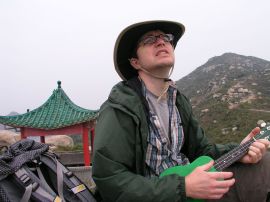
James channeling his inner Bob Dylan on car-free Lamma Island, Hong Kong, where we stayed with a British CS host
I think what people find most strange about the whole arrangement is that you are staying in the home of someone that you don’t know. For whatever reason, it doesn’t seem strange to me at all. You can pretty easily tell from the profiles that your potential host/guest is someone who seems nice, interesting and responsible. Usually I look for people with whom we have things in common.
For example, I just arranged to stay with a lovely woman in Helsinki, Finland who is completing her masters degree in environmental economics. I told her in my request that James also has a degree in this field. She was pretty excited to meet us! She actually attended the most recent United Nations climate negotiations in Mexico. When she got back to me to say that we could stay with her, she sent me the link to her blog from that trip: http://enterculture.org/?cat=5. Cool, right?
So far, James and I have been lucky enough to stay with CS hosts in Bangalore, India, Hong Kong, Bangkok, Thailand, and Phnom Penh, Cambodia. They were all wonderful experiences. The apartment in Bangkok that we stayed in was particularly lovely – we had own own giant bedroom in a spacious apartment, and free access to their pool and rooftop garden.

Florian & Cillia, our CS hosts in Bangkok. They are both French and have been living in Thailand for about a year.
To “pay” people back, we have made them special meals or taken them out to dinner, done odd jobs around the house (James is especially handy), given them little gifts. But they really don’t expect that. The people who have hosted us have been environmental activists, bankers, teachers, hotel industry professionals, factory managers. Some of them are natives of the places where they now live, others are not. James and I got a chance to host someone for about a week in Athens before we left who was in town for a Wilderness First Responder course at OU and it was a really wonderful experience as well.
Here’s a fun story: When I was looking for CS hosts in Phnom Penh, I came across the profile of a guy who seemed very nice who was willing to show people around. As I was writing him a message about when we would be arriving, I noticed that I knew one of his friends: a Thai woman that I had worked with at OU! Turns out this CS guy named Bruce actually worked at OU too as a residence hall director and we actually had met before! No wonder he looked nice to me. Bruce has just opened a restaurant in Cambodia and he invited us for a meal there when we arrived. He also brought us along to a birthday party on a boat that cruised along on the Mekong river. It was great connecting with someone from Athens so far away from home.
We are getting ready to stay with two more CS hosts here in Japan over the next week, in Kyoto and Osaka. The guy in Kyoto actually keeps a whole furnished house there just for CS guests! Apparently he lives elsewhere with this family. How ’bout them apples? Seems he’s rather wealthy and has had many, many extraordinary CS experiences abroad during his own travels and this is his way of giving back.
So, all in all couch surfing is wonderful because it allows you to connect much more intimately with the places you are visiting, it lessens the costs of travel, it gives you access to a real home instead of just a room, and it creates many new friendships. We absolutely love it and we recommend it to all of you! Why not just offer to meet someone for coffee or a drink for starters? You can always say no to any request, no questions asked.
I have recently uploaded lots more pictures on Flickr, including many from Japan. There are some fun ones in there of Laura and I practicing our calligraphy and ikebana skills. Oh, and I recently made some lovely postcards at a Japanese paper making workshop that will be sent out today to 3 lucky recipients. Who knows what you’ll receive when you request yours?
Love and hugs to you all!
Bangkok is full of liars and other Truths
One of the funny things that happens to your brain when you’re traveling is that it becomes receptive to Truths which clamor to be Declared:
- Bangkok Is Full of Liars.
- Visting the Killing Fields is a Gruesome and Strange Thing for a Tourist To Do.
- Dragonfruit Are As Beautiful Inside as Outside, But They Don’t Taste Like Anything.
- Cambodia Is Extraordinary, No Wonder Everyone Loves It Here.
- It Is Hard to Look at a Rural Landscape Here and Not Imagine Bombs Exploding Over It.
- Cambodian People Seem Amazingly Happy and Relaxed*
- Visiting With Friends (Or Friends-of-Friends) Really Enhances One’s Experience of a Place.
In order for a statement to be a Truth, and not just true, it must conform to all of the following conditions:
- It was discovered/confirmed through first hand travel experience
- It enjoys wide agreement among all travelers “in the know”
- It has the capacity to spawn discussions on the statement’s deeper significance and/or its corollaries
- Voicing it out loud (particularly over a glass of wine) leads to a feeling of calm self-assurance, a self-assurance born from the knowledge that the world is both simple and complicated, and more importantly, that it is in fact knowable.
- You never tire of revisiting it
Glorious ancient architecture might also be added to that list, though we have yet to travel to Angkor Wat, so I’ll get back to you on that.
Phnom Penh itself is a really accessible and lively city with delights at every corner. To wit:
If you’re having trouble seeing these images in a larger format, just click on our “More Photos” link on the blog where they are all uploaded in full format glory.
It is Khmer New Year right now, so I will wish you all a happy new year! If you want to do it the Khmer way, then go douse someone you know in water and flour, then swing a big stick at a clay pot (see photo below).
Love to you all! Don’t forget to request postcards!
Sonia & James
p.s. I’ll tell you about the Bangkok liars when we go back to Bangkok. Bangkok is also full of wonderful people and things, hopefully that goes without saying.
p.p.s. In case you hadn’t already heard, our dog Annie is now residing in doggie heaven. Thank you for your condolences.
